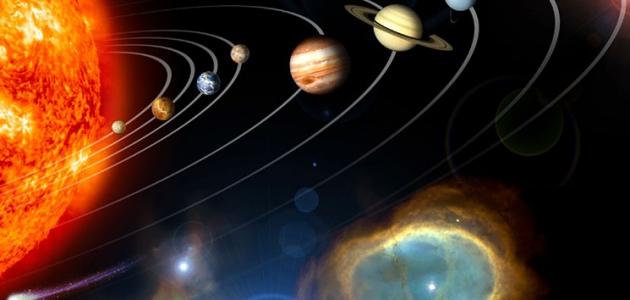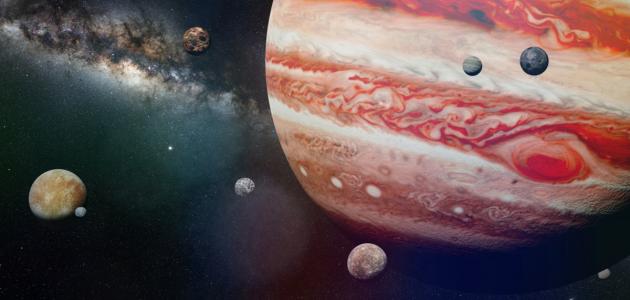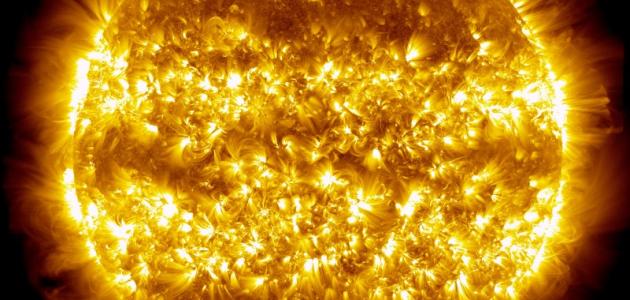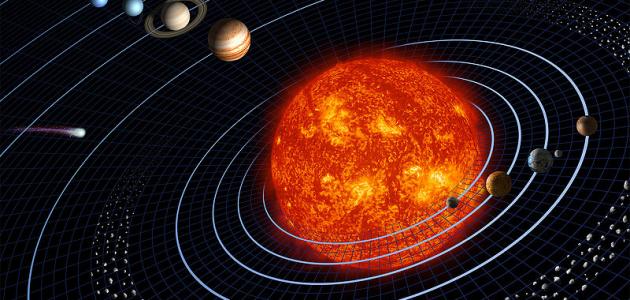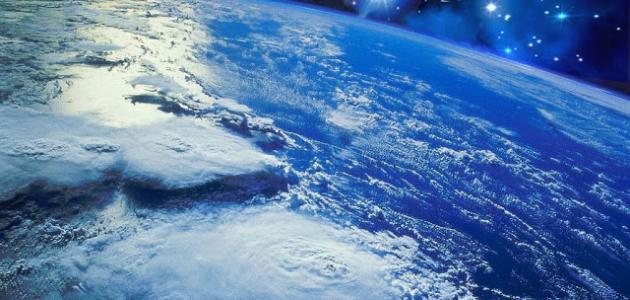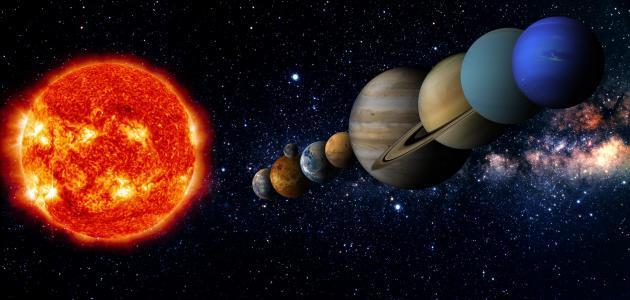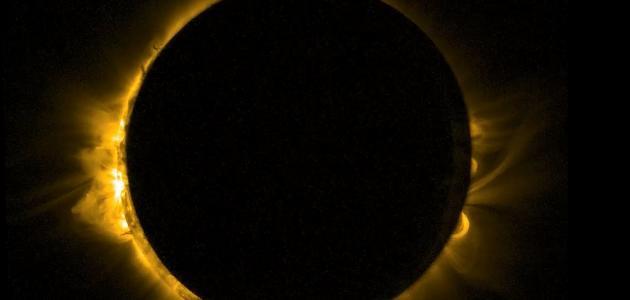Characteristics of the planets of the solar system
The solar system consists of eight planets; They are: Mercury, Venus, Earth, Mars, Jupiter, Saturn, Neptune, and Uranus. Here are the most important characteristics related to those planets:
Orbital properties
The planets revolve around the sun, and here are some of the phenomena related to the movement of the planets:
- Rotation period: The period of rotation or the period of rotation refers to the time it takes for a planet to complete one complete revolution on its axis in comparison with or in relation to the stars and fixed celestial bodies. The following table shows the rotation period of the planets of the solar system:
| Planet name | rotation period (hour) |
|---|---|
| Mercury | 1407.6 |
| Flower | -5832.5 |
| Earth | 23.9 |
| Mars | 24.6 |
| Purchaser | 9.9 |
| Saturn | 10.7 |
| Uranus | -17.2 |
| Neptune | 16.1 |
- Length of the day: The length of a day or day refers to the average number of hours it takes for the sun to travel from its position at a point on the equator or the same longitude and back to the same point from which it set off. The following table shows the length of the day for the planets of the solar system:
| Planet name | length of day (hour) |
|---|---|
| Mercury | 4222.6 |
| Flower | 2802.0 |
| Earth | 24.0 |
| Mars | 24.7 |
| Purchaser | 9.9 |
| Saturn | 10.7 |
| Uranus | 17.2 |
| Neptune | 16.1 |
- Distance from the sun: It is also called the semi-major axis, and it is the average distance between the sun and the planet, and since the planets revolve around the sun in elliptical orbits, so there is a point on the orbit in which the planet is as close as possible to the sun called perihelion, and a point in which the planet is farthest from the sun It is called the solar apogee, and the average distance from the sun refers to the midway between those two points, and it is defined by the astronomical unit “AU”, which for Earth is equal to 1 AU, i.e. 1 astronomical unit. The following table shows the distance between the planets of the solar system and the sun:
| Planet name | The distance from the sun (106 how much) |
|---|---|
| Mercury | 57.9 |
| Flower | 108.2 |
| Earth | 149.6 |
| Mars | 227.9 |
| Purchaser | 778.6 |
| Saturn | 1433.5 |
| Uranus | 2872.5 |
| Neptune | 4495.1 |
Read also:How many moons does Jupiter have?
the presence of satellites
All planets revolve around the sun, and some of them have moons such as Earth and Mars, and the number of moons reaches more than 200 moons distributed among the planets, as giant planets such as Jupiter and Saturn lead the largest number of moons, bringing their confirmed number of existence, which has been named to 53 moons for each From them, and on the other hand, some terrestrial or rocky planets do not have moons such as Mercury and Venus, and what should be noted is the different moons in their shapes, types, and sizes, and some of them have an atmosphere and hidden oceans, and some of them have no air, and here comes a brief description of some of the planets’ moons:
- Earth's Moon: The earth has one natural satellite, which helps the continuation of life on the planet because of the stabilizing force resulting from it.
- Mars moons: Mars has two small moons orbiting it, one of which is called Phobos and it is slowly cracking apart with time.
- Jupiter's moons: There are several moons orbiting Jupiter, such as the icy moon Europa.
- Saturn's moons: There are several moons orbiting Saturn in the form of rings, and one of those moons is the same size as the planet itself.
- Moons of Uranus: The planet Uranus has several moons named after literary figures.
- Neptune's moons: The planet Neptune has several moons, including the icy Kuiper belt Triton.
The following table shows the number of moons that revolve around each planet of the solar system:
Read also:Why was the planet Mercury called by this name?| Planet name | confirmed satellites | undiscovered moons | The total number of satellites |
|---|---|---|---|
| Mercury | 0 | 0 | 0 |
| Flower | 0 | 0 | 0 |
| Earth | 1 | 0 | 1 |
| Mars | 2 | 0 | 2 |
| Purchaser | 53 | 26 | 79 |
| Saturn | 53 | 29 | 82 |
| Uranus | 27 | 0 | 27 |
| Neptune | 14 | 0 | 14 |
The presence of planetary rings
The solar system includes four planets that have rings - consisting of cosmic dust - revolving around them, and those planets are called gaseous planets. They are Jupiter, Saturn, Uranus, and Neptune, as Saturn is the planet that has the most number of rings around it, which were discovered a long time ago, while other gaseous planets were revealed to have rings around them in the seventies of the last century, and the rings around them are distinguished. Neptune, Uranus, and Jupiter are pale in color, fewer in number, and much smaller than the rings of Saturn.
Read also:How does the moon become a crescent?surface nature
The planets can be divided according to the nature of the surface they are composed of into two groups; They are:
- Terrestrial planets: Terrestrial or rocky planets are similar in composition to Earth, as they consist of minerals and rocks, and a number of topological features such as volcanoes, craters, and valleys, and their center consists of molten heavy metals, and on the other hand, terrestrial planets contain a few moons that revolve around them, The solar system contains four rocky planets, which are the planets closest to the sun, namely Mercury, Venus, Earth, and Mars.
- Giant planets: Most of the giant planets consist of gases such as helium and nitrogen, in addition to a number of relatively small rocks. It includes four planets: Jupiter, Saturn, Uranus, and Neptune.
Planetary gravity
Each planet has its own gravity, and the acceleration of gravity at the surface at the equator is measured in meters per second squared (m/s).2, And the effect of rotation is taken into account, and the earth’s gravity is expressed as “G”, and therefore the gravity of other planets is determined by multiples of “G”, and in order for any body to escape from the gravity of its planet, it must have an initial velocity that enables it to escape from the gravitational field of any celestial body , which is called escape velocity. The following table shows the magnitude of gravity and the escape velocity of the planets of the solar system:
| Planet name | gravity (m/s)2) | Escape velocity (km/sec) |
|---|---|---|
| Mercury | 3.7 | 4.3 |
| Flower | 8.9 | 10.4 |
| Earth | 9.8 | 11.2 |
| Mars | 3.7 | 5.0 |
| Purchaser | 23.1 | 59.5 |
| Saturn | 9.0 | 35.5 |
| Uranus | 8.7 | 21.3 |
| Neptune | 11.0 | 23.5 |
Atmospheric properties
The characteristics of the atmosphere surrounding each planet differ, and the following is an explanation of the atmospheres surrounding each planet:
- Mercury: Mercury is surrounded by a very light atmosphere, consisting mainly of sodium and potassium gases.
- Venus: The atmosphere of Venus consists mainly of carbon dioxide, in addition to small amounts of nitrogen, neon, helium and argon.
- Earth: Its atmosphere consists mainly of oxygen and nitrogen, in addition to a number of secondary gases, namely helium, carbon dioxide, argon, and ozone.
- Mars: Mars' atmosphere is surrounded by a very thin layer of primarily carbon dioxide, as well as argon, nitrogen, and small amounts of oxygen and water vapor.
- Purchaser: Its atmosphere is composed primarily of hydrogen and helium, with very small amounts of ammonia, water, methane and other carbon compounds.
- Saturn: Its atmosphere consists mainly of helium and hydrogen, in addition to ammonia and methane.
- Uranus: Uranus' atmosphere is made up primarily of hydrogen, with small amounts of helium and methane, and appears blue because methane absorbs other wavelengths.
- Neptune: The atmosphere of Neptune consists mainly of helium and hydrogen, and it also consists of methane at a rate of 2.5% to 3%, and the clouds in its atmosphere are composed of methane crystals, and it appears in a blue color due to the absorption of methane at other wavelengths.
